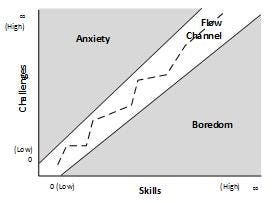We all know the feeling of being so immersed in a game that we lose all track of time. Well, this feeling of deep immersion is known in Positive Psychology circles as: Flow. It's comprised of eight stages and can be designed into any gameplay experience.

As gamers we all know the feeling of being so immersed in our game-world that we lose all track of time; effortlessly powering through missions, monsters and bosses, forgetting the rest of the world exists. However, being in the zone is not exclusive to gamers, it is a state of mind universal for all human beings. In positive psychology, this feeling is known as optimal experience – or more simply ‘Flow’.
In the crowded gaming marketplace creating Flow inducing gameplay can set your game apart from the competition in terms of deeper enjoyment, positive feedback and higher player retention rates.
As a game designer and academic my research lead me to uncover how the careful structuring of gameplay content can be created to trigger Flow. For those who’d like a deeper read, you can access my full doctoral thesis on the subject. However, in this piece I’ll be keep it light and cover the basics of Flow and how it can be described in terms of the gameplay experience.
The feel good factors
Developing motivating and enjoyable experiences are key for meaningful player interaction. Game design is a complex balance of factors that create the player journey; technical, visual, aural, psychological. There isn’t a cure-all solution to creating the perfect game balance. However, the eight conditions comprising a Flow state provide a platform from which we can gain a high-level view.
It was the research of Mihaly Csikszentmihalyi (pronounced Me-High Chick-Sent-Me-High) who found flow to be a common phenomenon across a wide range of activities and cultures. His understanding of flow revealed a universal theory of enjoyment in human beings. This table outlines the eight conditions of Flow (no.3 clear goals and feedback are now generally considered as separate conditions) outlined by Csikszentmihalyi's, (1990) in his book Flow: The Psychology of Optimal Experience.
Eight Conditions for Finding Flow |
1. A Challenging Activity That Requires Skills |
2. The Merging of Action and Awareness |
3. Clear Goals and Feedback |
4. Concentration on the Task at Hand |
5. The Paradox of Control |
6. The Loss of Self-Consciousness |
7. The Transformation of Time |
Flow happens naturally when we undertake an activity where we feel that our skills are well matched to the challenges we encounter. As we progress with our activity, flow happens because we don’t get distracted or bored by what we’re doing; neither do we feel overly anxious or frustrated by its challenges. Flow, is being balanced within an activity; between skill and challenge, out of which enjoyment arises. And if we enjoy what we are doing, then ultimately we are more motivated to keep on doing it.

Structuring flow
Firstly, flow starts with a challenging activity that matches a person’s level of skill; let’s use the game World of Warcraft (WoW) as our example as most people are familiar with the gameplay style. A suitable challenge for a novice player would be to hunt and kill an animal. This challenge builds on the skills of, navigation; locate target and move character, weapon use; fire weapon to kill animal and item collection; pick up items-drops from animal. What’s key to jump-starting flow is our ability to see ourselves being able to complete the challenge of the mission before we undertake it.
Secondly, as our confidence in the task grows, we are able to merge our action and awareness, combining skills so that our actions begin to feel more spontaneous. For example, our WoW player has combined those three skills into one hunting skill. From now onward they will not have to think about each action separately as those actions are now merged. For the player, the components of their hunting skill can now be transferred to another more taxing challenge.
Third and fourth, to keep flow going, we must have a clear goal to aim for and receive relevant feedback on our actions. In our WoW hunting example; the goal will have been defined by following a mission, such as kill 10 animals or collect 5 item drops. The feedback on this goal should be either, immediate; the noise of the weapon firing or animal dying, or come afterwards; such a onscreen success message. Importantly, feedback is there to allow us to judge how well and how far we have progressed against a given target. Feedback is crucial as it enables us to adjust our behaviour and feel satisfaction, as we can progress towards our target.
Feeling flow
By following this structure of goal-based challenge, combining skills and providing feedback, we enable the fifth flow condition to emerge; the ability to concentrate on the task at hand. Being able to concentrate, without distraction, on what we are doing acts as a powerful motivator enabling us to visualise our progression path.
In the sixth stage of flow this motivator is felt as a psychological sense of control over the task and our interactions. To put it another way, you won’t experience stress, frustration or anger, as you feel in control of what is happening. Even if, ultimately, you are not in control of the outcome. It is this sense of control, over what you are doing right now, that reduces anxiety and heightens enjoyment. Immersion, succinctly describes this state of mind; we feel in control, know how to progress, so there is nothing to stop us becoming immersed in the fun of the game.
Now finally, at stages seven and eight of your gameplay challenge you are in a complete state of Flow, all self-consciousness disappears as you are happily lost on task, totally unaware of the passage of time, simply enjoying playing the game.
Buidling Flow
To bring a bit of flow into your game design, structure player-tasks into manageable combinations by applying the first four flow stages; 1) define the challenge and list what skills will be required, 2) define a clear goal to achieve, 3) utilise ways to combine player skills so they can smoothly achieve your game goals, 4) define what feedback the player needs to receive; be it immediate onscreen notifications, or a defined point where the player can stop and review their long-term progress though scores or stats.
You can then use the latter four stages of flow to assess and measure how well you have set-up your gameplay challenge; this is useful in play-testing and small scale focus groups. Stage 5) were players able to concentrate on each task, or did other in-game features distract from the action 6) Did the players feel a sense of control over their progression, or did they begin to feel overwhelmed or bored. And the most effective indicators for an enjoyable game; 7) did your player lose themselves on task, 8) and forget to watch the clock?
As Csikszentmihalyi states optimal experiences are reported to occur within sequences of activities that are goal-directed and bounded by rules - activities that require the investment of attention and that could not be done without skills. I consider this statement be a great way to describe what constitutes the bones of a game. I hope this article has provided you with an appreciation of how flow-based gameplay can immerse your players and how that can be beneficial in a crowded marketplace.
Note: If you want to look more at measuring the flow of your gameplay I recommend reading GameFlow: A Model for Evaluating Player Enjoyment in Games by Sweetser & Wyeth, (2005).
Csikszentmihalyi, M. (1990). FLOW : The Psychology of Optimal Experience. Harper and Row.
Sweetser, P., & Wyeth, P. (2005). GameFlow: A Model for Evaluating Player Enjoyment in Games. Computers in Entertainment (CIE), 3(3), 1–24.
Dr Hazel Bradshaw is a gameplay UX designer, researcher and educator and the founder of Driedfrog design studio she's on a mission to make learning new stuff more enjoyable through gaming. www.driedfrog.com
Read more about:
BlogsAbout the Author(s)
You May Also Like








